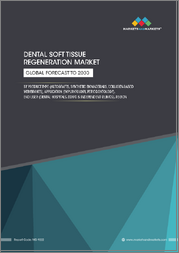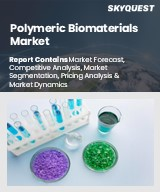
|
시장보고서
상품코드
1813299
세계의 바이오소재 시장 예측(-2032년) : 유형별, 용도별, 지역별 분석Biomaterials Market Forecasts to 2032 - Global Analysis By Type (Metallic Biomaterials, Polymeric Biomaterials, Ceramic Biomaterials, Natural Biomaterials and Other Types), Application and By Geography |
||||||
Stratistics MRC에 따르면 세계의 바이오소재 시장은 2025년 494억 달러를 차지하고, 예측 기간 동안 CAGR은 9.3%로 성장하여 2023년까지 920억 6,000만 달러에 이를 것으로 예측됩니다.
바이오소재는 의료 또는 치료 목적으로 생체 시스템과 상호 작용하도록 설계된 천연 또는 합성 물질입니다. 금속, 세라믹, 폴리머, 복합재료 등이 있으며 조직과 기관의 기능을 회복, 대체 및 강화하기 위해 신중하게 설계되었습니다. 임플란트, 인공 장비, 약물 전달 시스템, 조직 공학 등의 용도에 사용되는 바이오소재는 유해한 면역 반응을 일으키지 않고 생체 적합성, 내구성 및 기능성을 나타내야 합니다. 그것의 디자인은 종종 특정 임상 요구를 충족시키기 위해 생물학, 화학, 재료 과학 및 엔지니어링을 통합합니다. 기술과 생물학의 가교가 됨으로써, 바이오소재은 현대의 건강 관리, 재생 의학, 생물 의학의 혁신을 추진하는데 중요한 역할을 하고 있습니다.
만성 질환과 심혈관 질환의 유병률 상승
세계적인 평균 수명 증가와 라이프스타일로 인한 건강 문제는 첨단 바이오소재에 대한 수요를 계속 증가하고 있습니다. 재생 요법과 수술은 이러한 물질의 적합성과 성능에 큰 혜택을 받고 있습니다. 낮은 침습 수술은 임상 현장에서의 사용을 더욱 촉진합니다. 헬스케어 요구의 확대는 바이오소재의 전략적 중요성을 강화하고 있습니다. 장기적인 시장 성장은 이러한 진화하는 의료 요건에 의해 형성됩니다.
엄격한 규제 및 임상 승인 프로세스
의료 등급 재료는 엄격한 안전과 성능 기준을 충족해야합니다. 승인주기는 길고 관할 구역에 따라 다르므로 컴플라이언스 비용이 증가합니다. 이러한 과제는 기술 혁신을 늦추고 상업화를 늦추고 있습니다. 중소기업의 경우 이러한 요구 사항을 극복하기가 어려울 수 있습니다. 규제의 단편화는 시장의 급속한 확대를 계속 제한하고 있습니다.
이식형 의료기기 채용 확대
인체 조직과의 통합에는 높은 생체적합성과 구조적 신뢰성을 나타내는 바이오소재가 필요합니다. 그 용도는 정형외과용 임플란트, 심장혈관용 스텐트, 치과용 수복물, 신경 보철 인터페이스 등 다양합니다. 재료 공학의 끊임없는 진보로 내구성, 기능성 및 환자 결과가 향상되었습니다. 낮은 침습으로 오래 지속되는 의료 솔루션에 대한 취향은 전 세계 건강 관리 시스템 전반에 걸쳐 증가하고 있습니다. 채용 동향은 바이오소재 분야의 기술 혁신 사이클을 가속화하고 있습니다.
높은 R&D 비용과 생산 비용
안전하고 효과적인 재료 개발에는 연구, 시험 및 규정 준수에 많은 투자가 필요합니다. 생산 공정은 전문화되고 자본 집약적인 경우가 많습니다. 중소기업은 기존 기업과의 경쟁에 어려움을 겪을 수 있습니다. 이러한 비용 압력은 제품 개발과 시장 개발을 늦추고 있습니다. 경제적 장벽은 여전히 성장에 뿌리깊은 위협입니다.
COVID-19의 영향 :
COVID-19의 대유행은 바이오소재 시장에 다양한 영향을 미쳤습니다. 처음에는 공급망 혼란, 제조 정체, 선택적 의료 절차 감소가 수요를 방해했습니다. 병원은 긴급 치료를 선호하고 임플란트와 보철물을 포함한 수술을 지연시켰습니다. 그러나 유행은 의료기기, 진단 및 개인보호구(PPE)에서 생체 재료의 사용을 가속화했습니다. 헬스케어 인프라와 연구에 대한 투자 증가는 시장 회복을 더욱 향상시켰습니다. 유행 후, 첨단 건강 관리 솔루션과 재생 의학에 대한 주목이 높아져 바이오소재 수요를 밀어 올렸습니다.
예측 기간 동안 고분자 바이오소재 분야가 최대화될 전망
고분자 생체 재료 분야는 적응성과 광범위한 임상적 유용성으로 인해 예측 기간 동안 최대 시장 점유율을 차지할 것으로 예측됩니다. 이 물질은 심장혈관, 정형외과, 상처 치료의 응용 분야에서 널리 사용됩니다. 유연성, 생체 적합성 및 사용자 정의 용이성으로 다양한 의료 요구에 이상적입니다. 생분해성 폴리머와 약물 방출성 폴리머의 혁신은 그 영역을 확대하고 있습니다. 또한 저침습 치료에도 대응하고 있습니다. 이 분야는 앞으로도 수량과 기술 혁신의 양면에서 리드해 나갈 것으로 보입니다.
예측 기간 동안 CAGR이 가장 높은 것은 안과 분야입니다.
예측 기간 동안 안과 분야가 가장 높은 성장률을 보일 것으로 예측되어 정밀한 안과 치료 솔루션에 대한 수요가 높아질 것으로 보입니다. 바이오소재는 안구내 렌즈, 각막 스캐폴드, 안약물전달 시스템에 사용됩니다. 인구의 고령화와 시력 장애 환자 증가가 채용을 촉진하고 있습니다. 투명하고 생체 적합성이 높은 재료는 수술 성적을 향상시키고 있습니다. 낮은 침습 안과 수술은 세계적으로 지지를 모으고 있습니다. 이 분야는 앞으로 수년간 급속히 확대될 전망입니다.
최대 점유율을 차지하는 지역
예측기간 동안 북미는 혁신적인 의료기술의 높은 채용률과 강력한 R&D 활동으로 최대 시장 점유율을 차지할 것으로 예측됩니다. 이 지역에서는 정형외과, 심장혈관 장치, 상처 치유, 미용 수술 등에서 바이오소재이 널리 사용되고 있습니다. 대학, 연구기관, 생명공학 기업 간의 전략적 제휴는 기술 혁신과 제품 개발을 촉진하고 있습니다. 확립된 업계 기업, 유리한 규제 정책, 낮은 침습 치료에 대한 선호도 증가가 전체로서 시장 확대에 박차를 가하고 있습니다. 개인화된 의료 및 재생 의료에 대한 의식이 높아짐에 따라 시장 전망이 강화되고 있습니다.
CAGR이 가장 높은 지역 :
예측 기간 동안 아시아태평양은 급속한 도시화, 건강 관리 인프라 확대, 첨단 의료 기술에 대한 투자 증가로 가장 높은 CAGR을 나타낼 것으로 예측됩니다. 만성 질환의 유병률 증가, 정형외과용, 심장혈관용, 치과용 임플란트에 대한 수요가 증가함에 따라 시장 성장이 더욱 강화되고 있습니다. 중국, 인도, 일본 등의 국가들은 환자 인구가 많아 의료 접근이 향상되어 중요한 역할을 하고 있습니다. 게다가 바이오소재의 연구와 현지 생산을 촉진하는 정부의 대처가 기술 혁신을 촉진하고, 이 지역을 향후 시장 확대 및 발전의 핫스팟으로 하고 있습니다.
무료 맞춤형 서비스
이 보고서를 구독하는 고객은 다음 무료 맞춤설정 옵션 중 하나를 사용할 수 있습니다.
- 기업 프로파일
- 추가 시장 기업의 종합적 프로파일링(3개사까지)
- 주요 기업의 SWOT 분석(3개사까지)
- 지역 세분화
- 고객의 관심에 응한 주요국 시장 추계, 예측, CAGR(주 : 타당성 확인에 따름)
- 경쟁 벤치마킹
- 제품 포트폴리오, 지리적 존재, 전략적 제휴에 기반한 주요 기업 벤치마킹
목차
제1장 주요 요약
제2장 서문
- 개요
- 이해관계자
- 조사 범위
- 조사 방법
- 데이터 마이닝
- 데이터 분석
- 데이터 검증
- 조사 접근
- 조사 자료
- 1차 조사 자료
- 2차 조사 정보원
- 전제조건
제3장 시장 동향 분석
- 성장 촉진요인
- 억제요인
- 기회
- 위협
- 용도 분석
- 신흥 시장
- COVID-19의 영향
제4장 Porter's Five Forces 분석
- 공급기업의 협상력
- 구매자의 협상력
- 대체품의 위협
- 신규 참가업체의 위협
- 경쟁 기업간 경쟁 관계
제5장 세계의 바이오소재 시장 : 유형별
- 금속 바이오소재
- 스테인레스 스틸
- 티타늄 및 티타늄 합금
- 코발트 크롬 합금
- 고분자 바이오소재
- 폴리메틸메타크릴레이트(PMMA)
- 폴리에틸렌(PE)
- 폴리프로필렌(PP)
- 폴리염화비닐(PVC)
- 실리콘
- 세라믹 바이오소재
- 알루미나
- 지르코니아
- 인산칼슘
- 천연 바이오소재
- 콜라겐
- 젤라틴
- 키토산
- 알긴산
- 실크
- 히알루론산
- 기타 유형
제6장 세계의 바이오소재 시장 : 용도별
- 심혈관계
- 스텐트 및 그래프트
- 심장 벨브
- 심박 조율기 및 이식 가능한 장치
- 정형외과
- 관절 치환술
- 뼈 플레이트 및 나사
- 척추 임플란트
- 안과
- 콘택트렌즈
- 안내 렌즈
- 각막 임플란트
- 치과
- 치과 임플란트
- 크라운 및 브릿지
- 틀니
- 상처의 치유
- 외과용 봉합사
- 조직 실란트 및 접착제
- 드레싱
- 신경학
- 신경 임플란트
- 션트
- 전극
- 기타 용도
제7장 세계의 바이오소재 시장 : 지역별
- 북미
- 미국
- 캐나다
- 멕시코
- 유럽
- 독일
- 영국
- 이탈리아
- 프랑스
- 스페인
- 기타 유럽
- 아시아태평양
- 일본
- 중국
- 인도
- 호주
- 뉴질랜드
- 한국
- 기타 아시아태평양
- 남미
- 아르헨티나
- 브라질
- 칠레
- 기타 남미
- 중동 및 아프리카
- 사우디아라비아
- 아랍에미리트(UAE)
- 카타르
- 남아프리카
- 기타 중동 및 아프리카
제8장 주요 발전
- 계약/파트너십/협업/합작투자(JV)
- 인수와 합병
- 신제품 발매
- 사업 확대
- 기타 주요 전략
제9장 기업 프로파일링
- BASF SE
- Evonik Industries AG
- Corbion NV
- Covestro AG
- Celanese Corporation
- Carpenter Technology Corporation
- Victrex plc
- Zimmer Biomet
- Johnson & Johnson
- Medtronic plc
- Stryker Corporation
- DSM-Firmenich
- Noble Biomaterials Inc.
- CoorsTek Inc.
- CeramTec GmbH
According to Stratistics MRC, the Global Biomaterials Market is accounted for $49.40 billion in 2025 and is expected to reach $92.06 billion by 2032 growing at a CAGR of 9.3% during the forecast period. Biomaterials are natural or synthetic substances designed to interact with biological systems for medical or therapeutic purposes. They can be metals, ceramics, polymers, or composites, carefully engineered to restore, replace, or enhance the function of tissues and organs. Used in applications such as implants, prosthetics, drug delivery systems, and tissue engineering, biomaterials must exhibit biocompatibility, durability, and functionality without causing adverse immune responses. Their design often integrates biology, chemistry, materials science, and engineering to meet specific clinical needs. By bridging technology and biology, biomaterials play a crucial role in advancing modern healthcare, regenerative medicine, and biomedical innovation.
Market Dynamics:
Driver:
Rising prevalence of chronic and cardiovascular diseases
Rising global life expectancy and lifestyle-induced health issues continue to elevate demand for advanced biomaterials. Regenerative therapies and surgical applications benefit significantly from these materials' compatibility and performance. Minimally invasive procedures further drive utilization across clinical settings. Expanding healthcare needs are reinforcing the strategic importance of biomaterials. Long-term market growth is being shaped by these evolving medical requirements.
Restraint:
Stringent regulatory and clinical approval processes
Medical-grade materials must meet rigorous safety and performance standards. Approval cycles are lengthy and vary across jurisdictions, increasing compliance costs. These challenges slow down innovation and delay commercialization. Smaller firms may find it difficult to navigate these requirements. Regulatory fragmentation continues to restrict rapid market expansion.
Opportunity:
Growing adoption of implantable medical devices
Integration with human tissue demands biomaterials that exhibit high biocompatibility and structural reliability. Applications span orthopedic implants, cardiovascular stents, dental restorations, and neuroprosthetic interfaces. Continuous advancements in material engineering are enhancing durability, functionality, and patient outcomes. Preference for minimally invasive and long-lasting medical solutions is rising across global healthcare systems. Adoption trends are accelerating innovation cycles within the biomaterials sector.
Threat:
High R&D and production costs
Developing safe and effective materials requires substantial investment in research, testing, and regulatory compliance. Production processes are often specialized and capital-intensive. Smaller players may struggle to compete with established firms. These cost pressures slow product development and market penetration. Economic barriers remain a persistent threat to growth.
Covid-19 Impact:
The Covid-19 pandemic had a mixed impact on the biomaterials market. Initially, disruptions in supply chains, manufacturing slowdowns, and reduced elective medical procedures hindered demand. Hospitals prioritized emergency care, delaying surgeries involving implants and prosthetics. However, the pandemic also accelerated the use of biomaterials in medical devices, diagnostics, and personal protective equipment. Increased investments in healthcare infrastructure and research further supported market recovery. Post-pandemic, rising focus on advanced healthcare solutions and regenerative medicine boosted demand for biomaterials.
The polymeric biomaterials segment is expected to be the largest during the forecast period
The polymeric biomaterials segment is expected to account for the largest market share during the forecast period due to their adaptability and broad clinical utility. These materials are widely used in cardiovascular, orthopedic, and wound care applications. Their flexibility, biocompatibility, and ease of customization make them ideal for diverse medical needs. Innovations in biodegradable and drug-releasing polymers are expanding their scope. They also support minimally invasive treatment approaches. This segment will continue to lead in both volume and innovation.
The ophthalmology segment is expected to have the highest CAGR during the forecast period
Over the forecast period, the ophthalmology segment is predicted to witness the highest growth rate increasing demand for precision eye care solutions. Biomaterials are being used in intraocular lenses, corneal scaffolds, and ocular drug delivery systems. Aging populations and rising cases of vision impairment are fuelling adoption. Transparent and biocompatible materials are improving surgical outcomes. Minimally invasive ophthalmic procedures are gaining traction globally. This segment is poised for rapid expansion in the coming years.
Region with largest share:
During the forecast period, the North America region is expected to hold the largest market share by high adoption of innovative medical technologies, and strong research and development activities. The region shows widespread use of biomaterials in orthopedics, cardiovascular devices, wound healing, and cosmetic surgery. Strategic collaborations between universities, research institutions, and biotech firms foster innovation and product development. Established industry players, favorable regulatory policies, and the rising preference for minimally invasive treatments collectively fuel market expansion. Growing awareness about personalized healthcare and regenerative medicine also strengthens the market landscape.
Region with highest CAGR:
Over the forecast period, the Asia Pacific region is anticipated to exhibit the highest CAGR by rapid urbanization, an expanding healthcare infrastructure, and growing investments in advanced medical technologies. Increasing prevalence of chronic diseases and rising demand for orthopedic, cardiovascular, and dental implants further support market growth. Countries such as China, India, and Japan play a significant role due to large patient populations and improving healthcare access. Additionally, government initiatives promoting research and local production of biomaterials encourage innovation, making the region a hotspot for future market expansion and development.
Key players in the market
Some of the key players in Biomaterials Market include BASF SE, Evonik Industries AG, Corbion N.V., Covestro AG, Celanese Corporation, Carpenter Technology Corporation, Victrex plc, Zimmer Biomet, Johnson & Johnson, Medtronic plc, Stryker Corporation, DSM-Firmenich, Noble Biomaterials Inc., CoorsTek Inc. and CeramTec GmbH.
Key Developments:
In July 2025, BASF signed a global framework agreement with CATL to supply advanced cathode active materials for lithium-ion batteries. While focused on energy storage, the partnership leverages BASF's biomaterials expertise in sustainable sourcing and circular chemistry to support CATL's green transformation goals.
In January 2025, Evonik formed a joint venture with Fuhua Tongda Chemical Co., Ltd. in Sichuan, China, to produce specialty hydrogen peroxide for medical and semiconductor applications. The venture builds on a prior licensing agreement and supports Evonik's biomaterials strategy by securing sustainable raw materials for high-purity processing.
Types Covered:
- Metallic Biomaterials
- Polymeric Biomaterials
- Ceramic Biomaterials
- Natural Biomaterials
- Other Types
Applications Covered:
- Cardiovascular
- Orthopedic
- Ophthalmology
- Dental
- Wound Healing
- Wound Healing
- Neurology
- Other Applications
Regions Covered:
- North America
- US
- Canada
- Mexico
- Europe
- Germany
- UK
- Italy
- France
- Spain
- Rest of Europe
- Asia Pacific
- Japan
- China
- India
- Australia
- New Zealand
- South Korea
- Rest of Asia Pacific
- South America
- Argentina
- Brazil
- Chile
- Rest of South America
- Middle East & Africa
- Saudi Arabia
- UAE
- Qatar
- South Africa
- Rest of Middle East & Africa
What our report offers:
- Market share assessments for the regional and country-level segments
- Strategic recommendations for the new entrants
- Covers Market data for the years 2024, 2025, 2026, 2028, and 2032
- Market Trends (Drivers, Constraints, Opportunities, Threats, Challenges, Investment Opportunities, and recommendations)
- Strategic recommendations in key business segments based on the market estimations
- Competitive landscaping mapping the key common trends
- Company profiling with detailed strategies, financials, and recent developments
- Supply chain trends mapping the latest technological advancements
Free Customization Offerings:
All the customers of this report will be entitled to receive one of the following free customization options:
- Company Profiling
- Comprehensive profiling of additional market players (up to 3)
- SWOT Analysis of key players (up to 3)
- Regional Segmentation
- Market estimations, Forecasts and CAGR of any prominent country as per the client's interest (Note: Depends on feasibility check)
- Competitive Benchmarking
- Benchmarking of key players based on product portfolio, geographical presence, and strategic alliances
Table of Contents
1 Executive Summary
2 Preface
- 2.1 Abstract
- 2.2 Stake Holders
- 2.3 Research Scope
- 2.4 Research Methodology
- 2.4.1 Data Mining
- 2.4.2 Data Analysis
- 2.4.3 Data Validation
- 2.4.4 Research Approach
- 2.5 Research Sources
- 2.5.1 Primary Research Sources
- 2.5.2 Secondary Research Sources
- 2.5.3 Assumptions
3 Market Trend Analysis
- 3.1 Introduction
- 3.2 Drivers
- 3.3 Restraints
- 3.4 Opportunities
- 3.5 Threats
- 3.6 Application Analysis
- 3.7 Emerging Markets
- 3.8 Impact of Covid-19
4 Porters Five Force Analysis
- 4.1 Bargaining power of suppliers
- 4.2 Bargaining power of buyers
- 4.3 Threat of substitutes
- 4.4 Threat of new entrants
- 4.5 Competitive rivalry
5 Global Biomaterials Market, By Type
- 5.1 Introduction
- 5.2 Metallic Biomaterials
- 5.2.1 Stainless Steel
- 5.2.2 Titanium & Titanium Alloys
- 5.2.3 Cobalt-Chromium Alloys
- 5.3 Polymeric Biomaterials
- 5.3.1 Polymethyl Methacrylate (PMMA)
- 5.3.2 Polyethylene (PE)
- 5.3.3 Polypropylene (PP)
- 5.3.4 Polyvinyl Chloride (PVC)
- 5.3.5 Silicone
- 5.4 Ceramic Biomaterials
- 5.4.1 Alumina
- 5.4.2 Zirconia
- 5.4.3 Calcium Phosphates
- 5.5 Natural Biomaterials
- 5.5.1 Collagen
- 5.5.2 Gelatin
- 5.5.3 Chitosan
- 5.5.4 Alginate
- 5.5.5 Silk
- 5.5.6 Hyaluronic Acid
- 5.6 Other Types
6 Global Biomaterials Market, By Application
- 6.1 Introduction
- 6.2 Cardiovascular
- 6.2.1 Stents & Grafts
- 6.2.2 Heart Valves
- 6.2.3 Pacemakers & Implantable Devices
- 6.3 Orthopedic
- 6.3.1 Joint Replacement
- 6.3.2 Bone Plates & Screws
- 6.3.3 Spinal Implants
- 6.4 Ophthalmology
- 6.4.1 Contact Lenses
- 6.4.2 Intraocular Lenses
- 6.4.3 Corneal Implants
- 6.5 Dental
- 6.5.1 Dental Implants
- 6.5.2 Crowns & Bridges
- 6.5.3 Dentures
- 6.6 Wound Healing
- 6.6.1 Surgical Sutures
- 6.6.2 Tissue Sealants & Adhesives
- 6.6.3 Dressings
- 6.7 Neurology
- 6.7.1 Neural Implants
- 6.7.2 Shunts
- 6.7.3 Electrodes
- 6.8 Other Applications
7 Global Biomaterials Market, By Geography
- 7.1 Introduction
- 7.2 North America
- 7.2.1 US
- 7.2.2 Canada
- 7.2.3 Mexico
- 7.3 Europe
- 7.3.1 Germany
- 7.3.2 UK
- 7.3.3 Italy
- 7.3.4 France
- 7.3.5 Spain
- 7.3.6 Rest of Europe
- 7.4 Asia Pacific
- 7.4.1 Japan
- 7.4.2 China
- 7.4.3 India
- 7.4.4 Australia
- 7.4.5 New Zealand
- 7.4.6 South Korea
- 7.4.7 Rest of Asia Pacific
- 7.5 South America
- 7.5.1 Argentina
- 7.5.2 Brazil
- 7.5.3 Chile
- 7.5.4 Rest of South America
- 7.6 Middle East & Africa
- 7.6.1 Saudi Arabia
- 7.6.2 UAE
- 7.6.3 Qatar
- 7.6.4 South Africa
- 7.6.5 Rest of Middle East & Africa
8 Key Developments
- 8.1 Agreements, Partnerships, Collaborations and Joint Ventures
- 8.2 Acquisitions & Mergers
- 8.3 New Product Launch
- 8.4 Expansions
- 8.5 Other Key Strategies
9 Company Profiling
- 9.1 BASF SE
- 9.2 Evonik Industries AG
- 9.3 Corbion N.V.
- 9.4 Covestro AG
- 9.5 Celanese Corporation
- 9.6 Carpenter Technology Corporation
- 9.7 Victrex plc
- 9.8 Zimmer Biomet
- 9.9 Johnson & Johnson
- 9.10 Medtronic plc
- 9.11 Stryker Corporation
- 9.12 DSM-Firmenich
- 9.13 Noble Biomaterials Inc.
- 9.14 CoorsTek Inc.
- 9.15 CeramTec GmbH



















